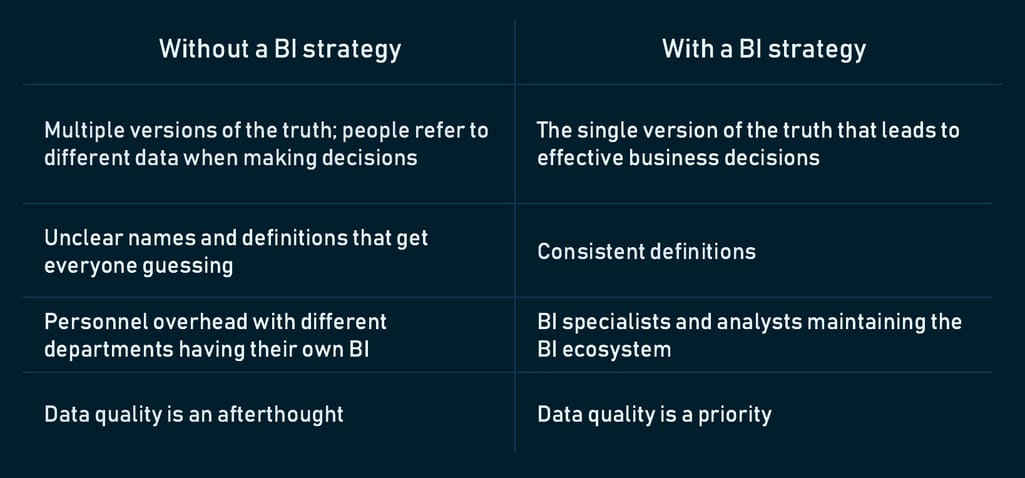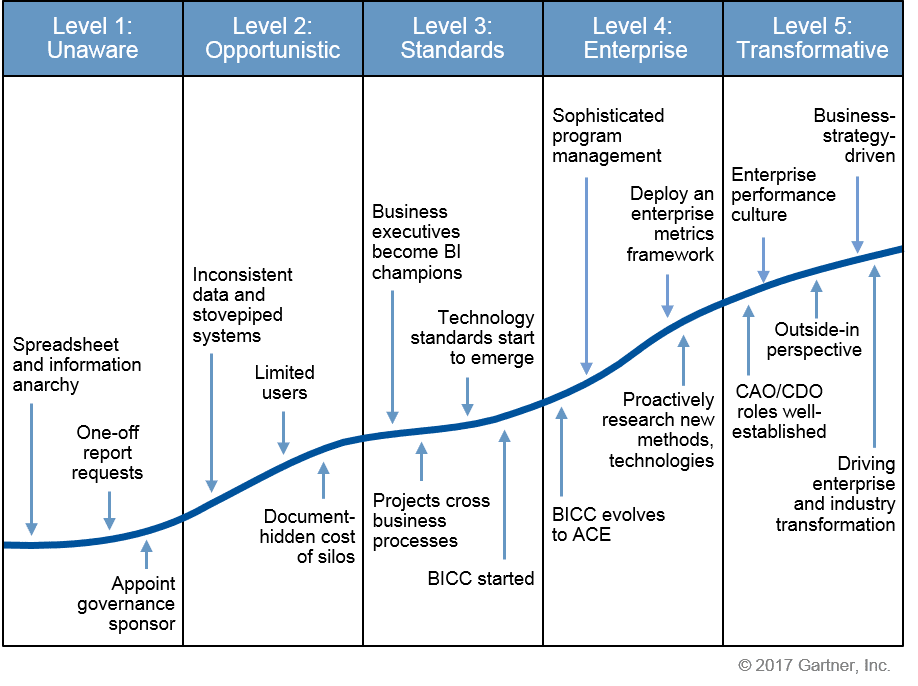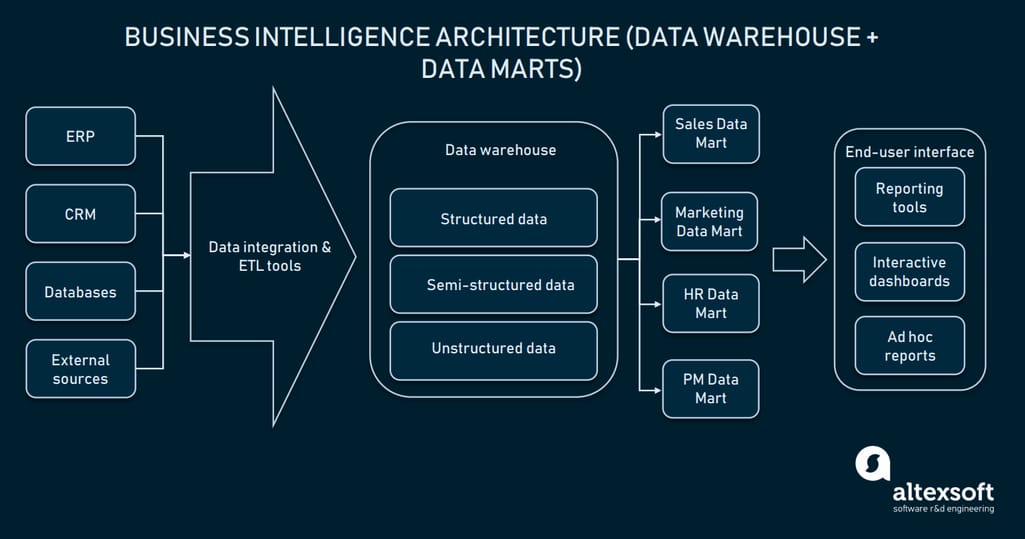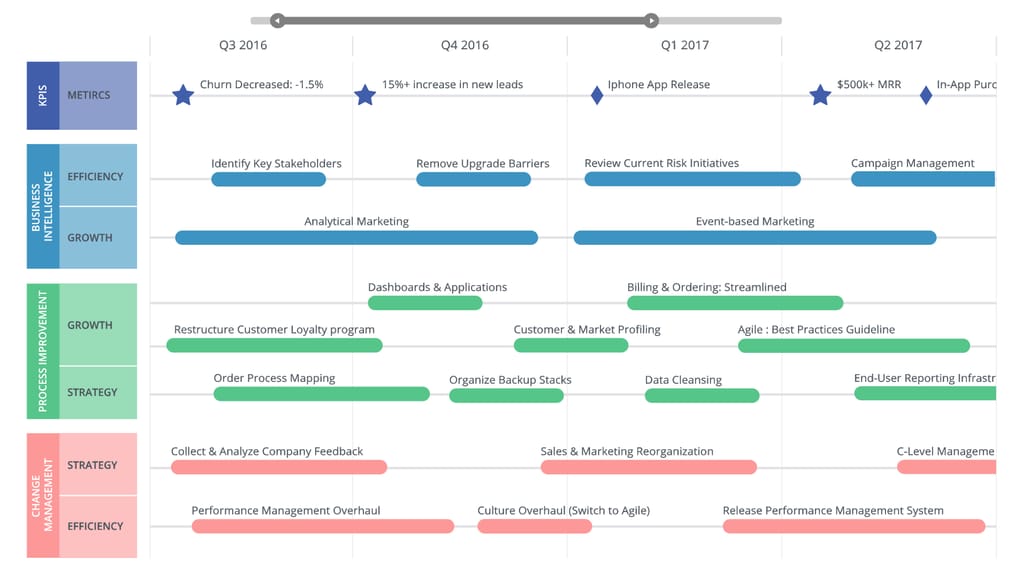Business Intelligence is the means of turning raw data into useful insights. It allows you to collect data from different sources, organize it, and then enjoy the analytics. Do you need it? Probably yes, as it’s the most balanced view of the business you can get. But as you can guess, starting such a complex endeavor requires some preparation and we will hopefully help you with that. And if you've already introduced some BI procedures in your company, this article will help you get organized as well. Now, let’s talk about your Business Intelligence strategy.
Why you need a BI strategy
A BI strategy will allow you to address all your data problems and needs, develop a cohesive system, and keep it maintained. What happens when you start implementing BI without a strategy? Basically, you focus too much on getting those graphs but no one in the company has an understanding of why and how to use them. Here’s a handy illustration of life before and after a BI strategy.
Previously, we posted a guide for implementing the BI practice in your organization. Now, we go into detail about one of the stages of your implementation plan - documenting a BI strategy.
Your BI strategy has three main elements:
Vision. Why are you building the BI practice in your company and what do you want to achieve?
People and processes. Who will define and run the BI strategy? And how?
Tools and architecture. Which dashboards and solutions do we want to build? For which areas? And how will they impact those areas?
So, as you look at your company’s corporate strategy, you envision what BI initiatives you want to start. Then that vision helps you choose the right people, those will use and maintain the chosen processes. To support people and processes, you use software tools. And finally, you establish the architectural blueprint for its development. Now, let’s go into detail on those steps. And we’ll start with those businesses that already have some form of BI.
Step 0. Assess your current BI ecosystem
To know where you’re heading, you must set a baseline. Say, you know that several departments have been using analytics, but the data has been mostly siloed - marketing people don’t have access to sales information, and customer support is tracking user feedback for their own internal purposes, or maybe there’s no analytics at all - basically, it seems to work but how effectively is unclear.
So, the first thing to do is talk to all players of the current BI processes: users and the IT team, department managers and stakeholders. As a result, you should have answers to the following questions:
- What’s your BI vision and or do you have any? How is that vision aligned with your IT and corporate strategy?
- Who are your BI players and how coordinated are they? Is there function overlap?
- How do you handle data management and data governance? How do you support BI users?
- What solutions are you using and how? Which of them bring value?
- Is your architecture aligned with corporate strategy? Are you sure that your licensing model works best?
Then, compile a SWOT analysis to organize what you’ve found. The SWOT analysis, one of the main strategy-building tools, will help you reveal your main assets and problems for the next stage.
Step 1. Create the vision
A vision is a combination of purpose and direction. There’s no strategy without a vision. It manifests itself in the form of many crucial decisions, like what data we will be sourcing or who will get access to the insights.
A vision also has a very mundane purpose: explaining to people in your organization -- who already have their favorite tools and processes -- why they need new ones, and how the transformation will happen.
Mike Biere, a former BI Analytics tools specialist for IBM, in his book The New Era of Enterprise Business Intelligence, offers this template for your BI vision:
Our corporate vision for BI is to create and support an infrastructure with secure and authorized access to data held anywhere in the enterprise. Our corporate standard for a BI tool is ________. We staff and measure our BI competency center based upon end-user satisfaction surveys and successful deployments. An important segment of our end-user community requires near real-time data access. Therefore, we have provided such an infrastructure to accommodate them. We currently support ___ users representing ___ % of our user population. Our goal is to increase the usage by ___ % by (date). We weigh the potential costs of increased BI usage against the business value and ROI we receive. Thus, we have a clear view of our success that is measured, accountable, and defensible.
Biere also notes that a vision articulated in this way will help fend off the executives whose only goal is to provide staff with cheap tools and get back to “real work.”
So, the vision statement should include such information as:
- Who’s going to be in charge of BI processes (i.e., establishing a Business Intelligence Competency Center that will govern BI software and architecture)?
- How is BI strategy aligned with IT and corporate strategy?
- How will we deliver and support BI solutions?
- What types of solutions do we plan to implement and where?
- What infrastructure are we planning to provide?
Finally, the vision is often accompanied by the BI Maturity model - the scale that tells you how mature your strategy is. You can find a few maturity model interpretations on the web, one very popular model coming from Gartner. According to them, there are five maturity levels for BI: Unaware, Opportunistic, Standards, Enterprise, Transformative. Using these models helps you identify your areas of advancement and what your next goals might be.
From rare reports to the role of Chief Analytics Officer
Source: How to Accelerate Analytics Adoption When Business Intelligence Maturity Is Low
Step 2. Establish BI governance processes
BI governance is about defining and implementing the BI infrastructure. (Not to be confused with data governance, which ensures the consistent use of data in an organization.) This includes three components:
- A BI governance team or people who will be responsible for governance processes
- BI tools and lifecycle management or the design and development of BI architecture
- User support from technical, functional, and data standpoints
BI governance team
Define BI governance members, their roles and responsibilities, functions, goals, and relationships to different structures in your company. Involve people from all levels, from executives to end users to bring all their perspectives to the table. So, it’s not really a group of BI experts, but rather a board of representatives from different company areas.
Larger enterprises, however, would benefit from an all-expert group in a Business Intelligence Competency Center (BICC). BICCs help identify data needs, establish data governance structures, oversee data quality, and general data integration processes. These are programmers, data scientists and analysts, specialists in relational databases and reporting tools. We recommend establishing such a team if you have a set of specialists to spare or resources to hire them.
BI tools and lifecycle management
BI lifecycle is a framework supporting BI efforts or specifically the architecture and tools used for it. Normally, the architecture looks like a pipeline starting at data sources (your ERP, external sources, etc.), then following a data integration process or ETL, where data is transformed and loaded to the repository (data warehouse and data marts) before the data is finally displayed in dashboards and interactive tools. There are a few architectural styles with different configurations of system elements.
The data warehouse + data mart configuration of BI architecture
Choosing BI tools. Depending on your level of confidence, you can get an end-to-end platform or create your own mix for every phase of the BI process. You can also find a perfect match price-wise or depending on whether you want to deploy on-premise or in the cloud. Use our guide to the best BI tools to help you with this task.
Drafting the data integration process. Define data sources and make sure your BI tool can assess them. Make sure the data is of high quality and set up processes for data preparation. Consider the architecture of a data warehouse.
Ensuring data presentation. Establish what types of reports and dashboards your system will display based on end-user needs and KPIs. Use our guide for some data visualization ideas where we also list some handy tools and libraries.
Performing user acceptance tests. User acceptance testing is an often overlooked but critical process, where you ask end users to perform a few tasks and collect output information about the system’s usability and performance. Then you prepare test cases, choose the time of testing and pick the required tools.
Performing training. End users should be trained to understand data basics and use a visualization platform. Before that, non-BI proficient members of the governance team should be trained to understand data transformation phases. Basically, recognize where there’s a knowledge gap and make sure to fill it as soon as possible.
User support
Apart from training, prepare to serve users and address their problems. Set up the feedback process and decide how you can react to it as quickly and cost-effectively as possible. Having a user support framework means that you cover them from three stand points:
Data education support - provide the knowledge base to let users find answers they have about incoming data: metadata, data purpose, metrics, data source, and so on.
Tool support - if possible, choose the tool with end users, then establish the agreed timeframes for issue response, and communicate what channels or contact they can use to get support.
Business support - make sure end users not only understand data but know how to derive value from it. Assign mentors in each department to help users learn how to provide value via BI tools, what metrics and dimensions to look for, and how to pinpoint data trends.
Having decided on how you approach all these tasks of the BI lifecycle, prepare your roadmap.
Step 3. Build a BI roadmap
Here, a roadmap is a visual document demonstrating deliverables at different stages of implementation within the timeline. By this step, you already have all the data you need to organize and schedule on the map, you only need to set up time frames and deliverables for every task.
The roadmap can encompass only high-level tasks like “Find a BI vendor” or be narrowed down to “Create a list of top ten best matches,” but for strategic mappings, the high-level overview will be enough. Below is an example of such a roadmap spanning three quarters. It has deliverables and milestones and tasks are divided by teams.
This roadmap has planned activities, KPIs, and, of course, implementation dates Source: Roadmunk
Our guide to building a roadmap should help you further, but we’ll repeat a few key ideas here.
- This roadmap will be viewed both by the internal (your governance and development teams) and external (end users) audiences, so it should combine a presentation-like format with technical aspects like timelines and metrics.
- You can divide tasks by responsible teams or task types (for example, training tasks, data visualization design tasks).
- Don’t forget deliverables and milestones. Deliverables help measure the progress with something tangible (all data sources are connected) and milestones are a conceptual signal of a new stage (data integration is complete).
Now, when you have your implementation steps down, it’s time to create a BI strategy document.
Step 4. Document a BI strategy
The logic behind a strategy document is that it will be a point of reference for the whole organization and will be used for the strategy presentation. What sections should go into this document?
- Executive summary. Written last but included in the very beginning, the summary gives an overview of steps and advancements you’re planning to make to reach your strategic goals. Why you’re starting this process, what your vision is, the timeframe, and deliverables.
- BI strategy alignment with corporate strategy. Go into detail about the value BI will bring to the organization, what problems it will solve, and how new processes will support the existing ones.
- Project scope and requirements. This is the place for your roadmap and BI architecture schema, where you go into detail about best vendors, architecture design, required staff and budget. Basically, explain the next steps after the strategy document is shared/presented.
- BI governance team. Let the audience meet the group responsible for the effort and communicate to end users who their immediate managers are.
- Alternatives. Here, review the options you’ve considered but chose to pass on and explain why they didn’t work. This will reduce the audience’s doubt and highlight the benefits of the final decisions.
- Assessment. Explain deliverables and the metrics of success you will be calculating. For example, end users must know why you’re reaching out for feedback or tracking their activity in the system.
- Appendices. Lastly, provide additional information like the list of picked vendors, organization charts, a glossary of terms, and even a corporate strategy document to revisit and compare.
Step 5. Review your BI strategy every year
How will you measure the success of your BI strategy? Quantitative metrics alone won’t do - you want to know how much better you understand your business or even how strong end users’ relationships have become.
You can revisit your BI Maturity model to determine whether you’re going in the right direction and establish metrics. The main one would be ROI, which describes if BI actually brought expected value.
Qualitative metrics would include things like the number of data access requests made by end users, increased productivity, or that deadlines are met more often.
You should also measure the effectiveness of the BI governance group - whether all goals were met and if the priorities haven’t shifted.
The art of strategizing
As we mentioned a few times in the article, a BI strategy is always created with a corporate strategy in mind. How will BI help you achieve your business goals? This is also the task of enterprise architecture - the practice of finding how tech can boost your overall goals.
To investigate a company’s current situation and propose changes, enterprise architects use frameworks - decades-old methods that help seeing the company from all its angles. TOGAF or the Zachman framework are also popular for BI strategizing. Filling in the templates, you can draft your requirements and align new processes without losing the vision. They are also useful for communicating your idea to the team and upgrading your project indefinitely.
As economist and Harvard Business School professor Michael Porter said, “The essence of strategy is choosing what not to do.” Indeed, even if developing a strategy is a time-consuming process, it allows you to eliminate errors that will inevitably arise without it.

